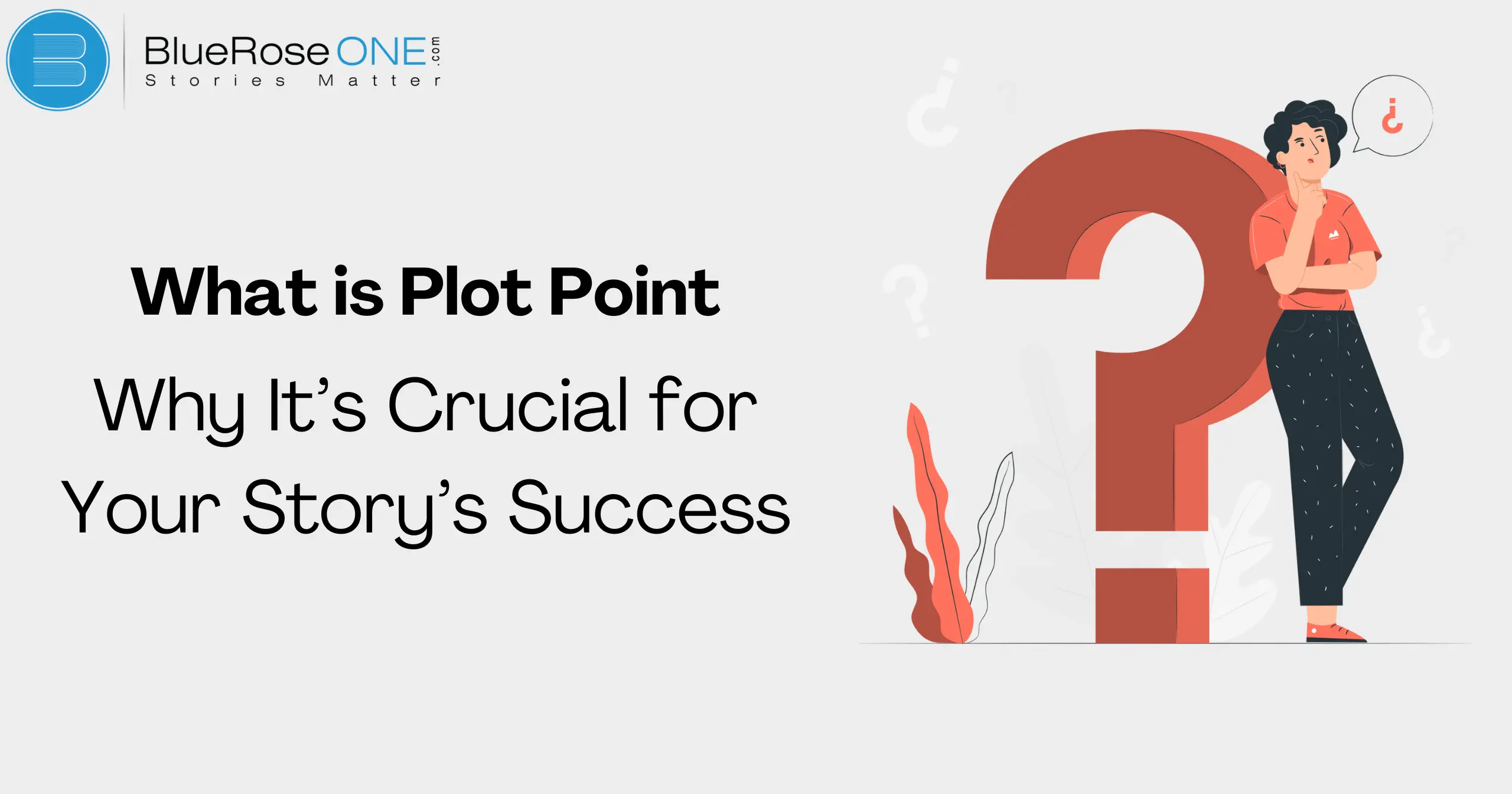Have you ever read a story that left you gripped and wanting to know what will happen next? That story probably contained strategically placed plot points. These pivotal points in a novel determine its course and keep readers interested. However, what is a plot point precisely, and why is it so important to the success of your story? Let’s explore and discover.
What is a Plot Point?
A pivotal moment in the story that advances the plot is called a plot point. It’s a turning point in the narrative where the protagonist is faced with a choice, revelation, or challenge that alters the plot. Your story’s plot points provide it with direction and structure.
Types of Plot Points
Major Plot Points
Major plot points are crucial events in a story that significantly impact the direction of the narrative. These include the inciting incident, which kicks off the main conflict, the midpoint, where the story takes a pivotal turn, and the climax, the peak of the story’s tension and action. Each major plot point ensures the story remains engaging, driving the characters and plot towards a satisfying conclusion.
Minor Plot Points
Minor plot points are the smaller, yet significant moments that occur throughout a story. These events help to move the plot forward and can include subplots, character developments, or unexpected obstacles.
While not as pivotal as major plot points, they add depth and complexity to the narrative, keeping the reader engaged. By weaving these smaller moments into your story, you create a richer and more compelling plot that keeps readers invested.
You may also like: What is Situational Irony? Definition, Examples and Tips for Writers
The Inciting Incident
An essential narrative device that initiates the primary action of your story is the inciting incident. It throws the protagonist’s regular life off balance and sends them on a quest.
The story moves ahead because of the core conflict that is created by this incident. If your story doesn’t have a compelling starting incident, it could be disorganized and uninteresting to readers. It’s a crucial component of any effective novel since it sets the scene and inspires your characters.
Examples
In J.K. Rowling’s Harry Potter and the Philosopher’s Stone, the inciting incident occurs when Harry receives his letter from Hogwarts.
Importance
The inciting incident is a crucial plot point that propels the story into motion. It marks the moment when the protagonist’s ordinary world is disrupted, compelling them to take action.
This plot point is important because it hooks the reader’s interest and sets the stakes for the narrative. Without a strong inciting incident, the story can lack direction and urgency, making it difficult to keep readers engaged from the beginning.
The First Plot Point
A story’s initial plot point is a pivotal point that alters the protagonist‘s course and initiates the major plot. It usually happens at the 25% point in a story, signaling the change from the setup to the major conflict.
This plot point draws the reader in and moves the narrative towards its conclusion by presenting the protagonist with important obstacles and objectives. In order to write stories that are both captivating and well-organized, one must comprehend this plot aspect.
Examples
In The Hunger Games, the first plot point is when Katniss volunteers to take her sister’s place in the games.
The first plot point is crucial because it kickstarts the main action of the story. It shifts the narrative from the setup phase to the main plot, creating momentum and engaging the reader.
This plot point often presents the protagonist with a challenge or a new direction, making it a turning point that propels the story forward. Without a strong first plot point, the story can feel aimless and fail to captivate the audience.
You may also read: What is Historical Fiction? Definition, Characteristics and Impact
Impact on the Story
Because it initiates the primary action of the narrative, the first plot point is essential. It gives the story energy and draws the reader in by moving from the setup to the main plot.
This story point is a pivotal moment that moves the storyline along because it frequently poses a problem or suggests a new course of action for the protagonist. If there isn’t a compelling beginning plot element, the story may seem aimless and fall flat on the audience.
The Midpoint
A story’s halfway is an essential storyline point. It appears midway in the story and frequently ushers in a major change of events or twist that advances the plot.
This turn of events can change the protagonist’s objectives or disclose important details, heightening the suspense and excitement. The halfway is crucial to a strong and captivating storyline since it changes the course of the story and keeps readers interested and involved.
Examples
In Pride and Prejudice, the midpoint occurs when Elizabeth Bennet receives Mr. Darcy’s letter, revealing his true character.
You may also like: What is External Conflict? Definition, Examples and Writing Tips
How it Changes the Story’s Direction
A plot element at the halfway mark drastically changes the course of the narrative. It’s a pivotal point in the story where characters must deal with fresh difficulties or discoveries that advance the plot.
This shift is crucial because it modifies the flow of events, intensifying tension and escalating conflict. In a mystery novel, for instance, the protagonist may decide to reevaluate their investigative plan when the true identity of a major suspect is revealed around the halfway point of the story.
These turns not only draw readers in, but they also influence how the story develops, keeping it lively and interesting all the way through.
The Second Plot Point
A plot point is a crucial passage that advances the story and changes its course in narrative structure. Specifically, the Second Plot Point happens close to the conclusion of the second act of a three-act play.
When the protagonist has a significant setback or discovery that heightens the conflict and builds up the climax, it acts as a pivotal moment.
In order to tell a gripping and interesting story, this scene is crucial because it raises the stakes, defines the tension, and gets the audience ready for the conclusion.
Examples
In The Lord of the Rings: The Fellowship of the Ring, the second plot point is when Frodo decides to take the Ring to Mordor alone.
Significance
The second plot point is a crucial juncture in your narrative that frequently sets up the climax. It acts as a pivotal moment that drives the story towards its denouement.
This plot point strengthens character development, heightens tension and suspense, and supports the main conflict of the narrative.
Writers can effectively direct the storyline towards a satisfactory ending by carefully putting the second plot point. This ensures that the story keeps readers interested and moving until the very end.
You may also like: How to Publish a Book? | Publish Your Book | BlueRoseOne
The Climax
A plot point in storytelling is a turning point that moves the story towards its climax, which is the moment when the drama and suspense are at their peak.
This is an important point since it frequently settles disputes and reveals the development or metamorphosis of the main character.
Consider it a pivotal moment that drives the narrative ahead and keeps readers interested in the course of events. Plot points are crucial for creating an engaging and memorable narrative since without them, a story may seem flat or unmotivated.
Examples
In To Kill a Mockingbird, the climax is the trial of Tom Robinson, where Atticus Finch makes his case.
Building Tension
The climax should be the most intense and exciting part of the story, resolving the central conflict.
The Resolution
In storytelling, a plot point is a pivotal moment that drives the narrative forward and often leads to significant changes for the characters or the storyline. One crucial plot point is “The Resolution,” where conflicts are finally resolved, and the story reaches its conclusion.
This moment is essential as it provides closure to the audience, answering questions raised throughout the plot and giving meaning to the characters’ journey. The resolution ensures that the story achieves its purpose, leaving a lasting impact on the reader or viewer.
Examples
In The Great Gatsby, the resolution occurs after Gatsby’s death, showing the aftermath of his pursuit of the American Dream.
Tying Up Loose Ends
A plot point in storytelling is an important turning point that advances the story and settles major problems. “Tying up loose ends” during the resolution stage is a crucial story component.
This is when all unresolved issues and side stories come to an end, satisfying viewers. This guarantees that there is no unanswered questions and that the tale feels finished.
Closing loose ends is essential because it provides readers or viewers with a sense of satisfaction and fulfillment, making the entire story’s journey meaningful and fulfilling.
You may alos like: How to Get More Book Reviews in 2025: Proven Tips for Authors
How to Identify Plot Points in Your Story
Tips and Techniques
- Look for moments of change or decision.
- Identify events that significantly impact the protagonist.
- Map out your story’s structure to see where the major turning points occur.
Why Plot Points are Crucial
Structure and Pacing
Plot points are crucial moments in a novel that advance the plot and foster character growth. They act as pivotal moments where important things happen and the plot takes a different route. Effective plot point structuring guarantees that the narrative keeps readers interested and the story moves forward.
Writers may generate tension, suspense, and powerful revelations that captivate viewers by arranging these moments with purpose. Writing a gripping narrative that keeps readers interested from start to finish requires a solid understanding of plot components.
Reader Engagement
Plot points are critical to reader engagement in storytelling. These crucial junctures advance the story and provide tension and mystery to the plot. Writers can build hooks that attract readers and compel them to read on by carefully positioning plot components.
These scenes frequently signal significant changes in the plot by illuminating character motivations, intensifying tensions, or resolving quandaries. Good plot points are crucial for creating stories that are memorable and captivating since they not only keep the reader interested but also influence the narrative’s overall structure and emotional impact.
Emotional Impact
The main reason narrative points are important in storytelling is because of their emotional impact. These turning points in a story not only move the plot along but also have a profound emotional impact on viewers or readers.
Plot points produce emotional peaks that hold viewers’ attention, whether it’s a shocking turn of events that upend the entire story or a pivotal discovery that alters the protagonist’s path.
They provide suspense, drama, and occasionally even catharsis to the narrative, giving it significance and lasting impact. Plot points are essentially critical moments that heighten the emotional journeys of both the audience and the characters.
How to Create Effective Plot Points
Brainstorming Techniques
- Use what-if scenarios to explore different possibilities.
- Think about your protagonist’s goals and challenges.
Plotting Strategies
- Outline your story to identify key events.
- Use a three-act structure to organize your plot points.
You may also read: List of Nobel Prize Winners in India (Updated)
Examples of Effective Plot Points in Popular Stories
Literature
In The Catcher in the Rye, the inciting incident is Holden Caulfield’s expulsion from school, which sets his journey into motion.
Movies
In Star Wars: A New Hope, the first plot point is when Luke Skywalker discovers the message from Princess Leia.
TV Shows
In Breaking Bad, the midpoint of the first season is when Walter White chooses to continue cooking meth after his initial success.
Common Mistakes with Plot Points
Overcomplicating the Plot
In narrative, the impact of important plot points can be diminished by an overly complex plot. Overuse of twists and subplots that don’t make sense in relation to the main story can confuse readers and lessen the impact of important events.
A plot point should have a distinct objective, either via progressing the narrative or providing significant character development.
By keeping your storyline simple, you can make sure that every point makes sense and moves the story along while keeping readers interested. The success and consistency of your story depend on this clarity.
Ignoring Character Development
In storytelling, ignoring character development can be a critical mistake when handling plot points. Plot points, pivotal moments that drive the narrative forward, rely heavily on the evolution of characters.
If characters remain stagnant or inconsistent, these key events may lack emotional impact or fail to resonate with readers. Developing characters allows plot points to feel natural and believable, enhancing the overall depth and engagement of your story. Ensuring character growth alongside plot progression is crucial for crafting compelling and memorable narratives.
Conclusion
Plot points are the pillars of your story, guiding its direction and engaging your readers. By understanding and effectively utilizing plot points, you can craft a compelling and memorable narrative.
















